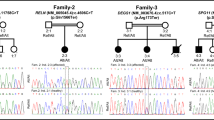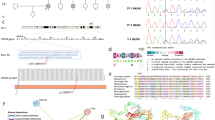Abstract
Background
Neu-Laxova syndrome (NLS) is a rare hereditary disorder featuring intrauterine growth retardation, remarkable oedema with skin restriction, limb contracture, ichthyosis, and craniofacial anomaly. NLS shares multiple overlapping characteristics with several other inheritable refractory diseases: for example, harlequin foetus and restrictive dermopathy. To date, many NLS patients have been described, although the number of NLS cases with clear genetic aetiology remains limited.
Objectives
To characterize the clinical and genetic features of NLS in two Chinese families.
Materials and Methods
Relevant skin tissue samples, blood specimens, and follow-up data from two unrelated Chinese families with perinatal fatal disorders were collected. To obtain a definitive diagnosis, six genes (ABCA12, LMNA, ZMPSTE24, PHGDH, PSAT1 and PSPH), previously implicated in the pathogenesis of inheritable refractory diseases with similar phenotypic expression to that of the affected members in the two pedigrees, were sequenced. We also performed tandem mass spectrometry, structural protein modelling, and immunohistochemical analysis to further support the genetic findings.
Results
New and recurrent missense mutations were identified in two genes (PHGDH and PSAT1) associated with NLS, which further supports the recent findings that NLS is genetically heterogeneous and could result from mutations in genes encoding enzymes of the L-serine biosynthesis pathway. Structural changes in PHGDH and PSAT1 proteins were revealed by molecular modelling. Finally, a tandem mass spectrometry assay and immunohistochemical analysis further corroborated the diagnosis of NLS.
Conclusion
This study is the first description of PHGDH and PSAT1 mutations in Chinese NLS patients, which strongly implicates them in the pathogenesis of NLS.
Similar content being viewed by others
References
Neu RL, Kajii T, Gardner LI, et al. A lethal syndrome of microcephaly with multiple congenital anomalies in three siblings. Pediatrics 1971; 47: 610–2.
Manning MA, Cunniff CM, Colby CE, et al. Neu-Laxova syndrome: detailed prenatal diagnostic and post-mortem findings and literature review. Am J Med Genet A 2004; 125: 240–9.
Coto-Puckett WL, Gilbert-Barness E, Steelman CK, et al. A spectrum of phenotypical expression of Neu-Laxova syndrome: three case reports and a review of the literature. Fetal Pediatr Pathol 2010; 29: 108–19.
Badakali M, Badakali A, Dombale V. Rare manifestations of Neu-Laxova syndrome. Fetal Pediatr Pathol 2012; 31: 1–5.
Carder KR, Fitzpatrick JE, Weston WL. What syndrome is this? Neu-Laxova syndrome. Pediatr Dermatol 2003; 20: 78–80.
Abdel Meguid N, Temtamy SA. Neu Laxova syndrome in two Egyptian families. Am J Med Genet 1991; 41: 30–1.
Abdel Meguid N, Temtamy SA. Evaluation of a fetus with Neu-Laxova syndrome through prenatal, clinical, and pathological findings. Fetal Diagn Ther 2005; 20: 167–70.
Horn D, Müller D, Thiele H, et al. Extreme microcephaly growth and mental retardation, flexion contraction, and ichthyotic skin in two brothers: a new syndrome or mild form of Neu-Laxova syndrome? Clin Dysmorphol 1997; 6: 323–8.
Thakur S, Pal L, Phadke SR. Lethal arthrogryposis with ichthyosis: overlap with Neu-Laxova syndrome, restrictive dermopathy and harlequin fetus. Clin Dysmorphol 2004; 13: 117–9.
Shaheen R, Rahbeeni Z, Alhashem A, et al. Neu-Laxova syndrome, an inborn error of serine metabolism is caused by mutations in PHGDH. Am J Hum Genet 2014; 94: 898–904.
Acuna-Hidalgo R, Schanze D, Kariminejad A, et al. Neu-Laxova syndrome is a heterogeneous metabolic disorder caused by defects in enzymes of the L-serine biosynthesis pathway. Am J Hum Genet 2014; 95: 285–93.
Lefévre C, Audebert S, Jobard F, et al. Mutations in transporter ABCA12 are associated with lamellar ichthyosis type 2. Hum Mol Genet 2003; 12: 2369–78.
Navarro CL, De Sandre-Giovannoli A, Bernard R, et al. Lamin A and ZMPSTE24(FACE-1) defects cause nuclear disorganization and identify restrictive dermopathy as a lethal neonatal laminopathy. Hum Mol Genet 2004; 13: 2493–503.
Biasini M, Bienert S, Waterhouse A, et al. SWISS-MODEL: modelling protein tertiary and quaternary structure using evolutionary information. Nucleic Acids Res 2014; 42(Web Server issue): W252–8.
Hart CE, Race V, Achouri Y, et al. Phosphoserine aminotransferase deficiency: a novel disorder of the serine biosynthesis pathway. Am J Hum Genet 2007; 80: 931–7.
Mattos EP, Silva AA, Magalhães JA, et al. identification of a premature stop codon mutation in the PHGDH gene in severe Neu-Laxova syndrome-evidence for phenotypic variability. Am J Med Genet A 2015; 167: 1323–9.
El-Hattab AW, Shaheen R, Hertecant J, et al. On the phenotypic spectrum of serine biosynthesis defects. J Inherit Metab Dis 2016; 39: 373–81.
Tabatabaie L, de Koning TJ, Geboers AJ, et al. Novel mutations in 3-phosphoglycerate dehydrogenase (PHGDH) are distributed throughout the protein and result in altered enzyme kinetics. Hum Mutat 2009; 30: 749–56.
Pind S, Slominski E, Mauthe J, et al. V490M, a common mutation in 3-phosphoglycerate dehydrogenase deficiency, causes enzyme deficiency by decreasing the yield of mature enzyme. J Biol Chem 2002; 277: 7136–43.
Neeve VC, Samuels DC, Bindoff LA, et al. What is influencing the phenotype of the common homozygous polymerase- mutation p. Ala467Thr? Brain 2012; 135: 3614–26.
Avila EM, Uzel G, Hsu A, et al. Highly variable clinical phenotypes of hypomorphic RAG1 mutations. Pediatrics 2012; 126: e1248–52.
Klaus V, Vermeulen T, Minassian B, et al. Highly variable clinical phenotype of carbamylphosphate synthetase 1 deficiency in one family: an effect of allelic variation in gene expression? Clin Genet 2009; 76: 263–9.
Acknowledgements and disclosures
Acknowledgements: We thank the two families and all subjects for taking part in this study. We also thank the families for granting permission to publish this information. This work was supported by Nature Science Foundation of China (81472867), a grant from the Fund of Shanghai JiaoTong University School of Medicine (14XJ10029), and a grant from Fund of sailing project of Shanghai municipal science and technology commission (15YF1407700). Conflicts of interest: none.
Author information
Authors and Affiliations
Corresponding author
About this article
Cite this article
Ni, C., Cheng, RH., Zhang, J. et al. Novel and recurrent PHGDH and PSAT1 mutations in Chinese patients with Neu-Laxova syndrome. Eur J Dermatol 29, 641–646 (2019). https://doi.org/10.1684/ejd.2019.3673
Accepted:
Published:
Issue Date:
DOI: https://doi.org/10.1684/ejd.2019.3673




